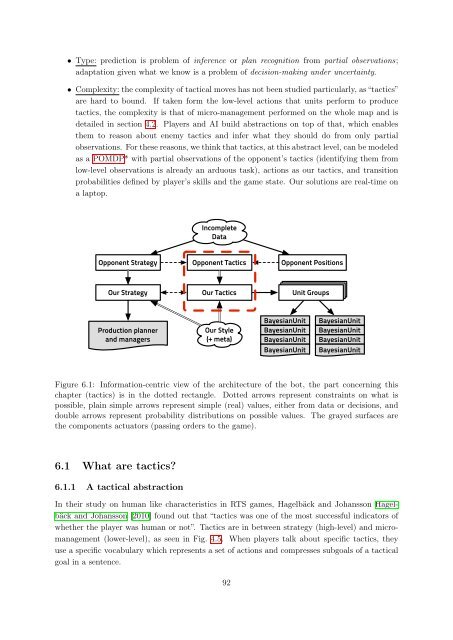Bayesian Programming and Learning for Multi-Player Video Games ...
Bayesian Programming and Learning for Multi-Player Video Games ...
Bayesian Programming and Learning for Multi-Player Video Games ...
Create successful ePaper yourself
Turn your PDF publications into a flip-book with our unique Google optimized e-Paper software.
• Type: prediction is problem of inference or plan recognition from partial observations;<br />
adaptation given what we know is a problem of decision-making under uncertainty.<br />
• Complexity: the complexity of tactical moves has not been studied particularly, as “tactics”<br />
are hard to bound. If taken <strong>for</strong>m the low-level actions that units per<strong>for</strong>m to produce<br />
tactics, the complexity is that of micro-management per<strong>for</strong>med on the whole map <strong>and</strong> is<br />
detailed in section 4.2. <strong>Player</strong>s <strong>and</strong> AI build abstractions on top of that, which enables<br />
them to reason about enemy tactics <strong>and</strong> infer what they should do from only partial<br />
observations. For these reasons, we think that tactics, at this abstract level, can be modeled<br />
as a POMDP* with partial observations of the opponent’s tactics (identifying them from<br />
low-level observations is already an arduous task), actions as our tactics, <strong>and</strong> transition<br />
probabilities defined by player’s skills <strong>and</strong> the game state. Our solutions are real-time on<br />
a laptop.<br />
Opponent Strategy<br />
Incomplete<br />
Data<br />
Our Strategy Our Tactics<br />
Unit UnitGroups<br />
Groups<br />
Production planner<br />
<strong>and</strong> managers<br />
Opponent Tactics Opponent Positions<br />
Our Style<br />
(+ meta)<br />
<strong>Bayesian</strong>Unit<br />
<strong>Bayesian</strong>Unit<br />
<strong>Bayesian</strong>Unit<br />
<strong>Bayesian</strong>Unit<br />
<strong>Bayesian</strong>Unit<br />
<strong>Bayesian</strong>Unit<br />
<strong>Bayesian</strong>Unit<br />
<strong>Bayesian</strong>Unit<br />
Figure 6.1: In<strong>for</strong>mation-centric view of the architecture of the bot, the part concerning this<br />
chapter (tactics) is in the dotted rectangle. Dotted arrows represent constraints on what is<br />
possible, plain simple arrows represent simple (real) values, either from data or decisions, <strong>and</strong><br />
double arrows represent probability distributions on possible values. The grayed surfaces are<br />
the components actuators (passing orders to the game).<br />
6.1 What are tactics?<br />
6.1.1 A tactical abstraction<br />
In their study on human like characteristics in RTS games, Hagelbäck <strong>and</strong> Johansson Hagelbäck<br />
<strong>and</strong> Johansson [2010] found out that “tactics was one of the most successful indicators of<br />
whether the player was human or not”. Tactics are in between strategy (high-level) <strong>and</strong> micromanagement<br />
(lower-level), as seen in Fig. 4.5. When players talk about specific tactics, they<br />
use a specific vocabulary which represents a set of actions <strong>and</strong> compresses subgoals of a tactical<br />
goal in a sentence.<br />
92


